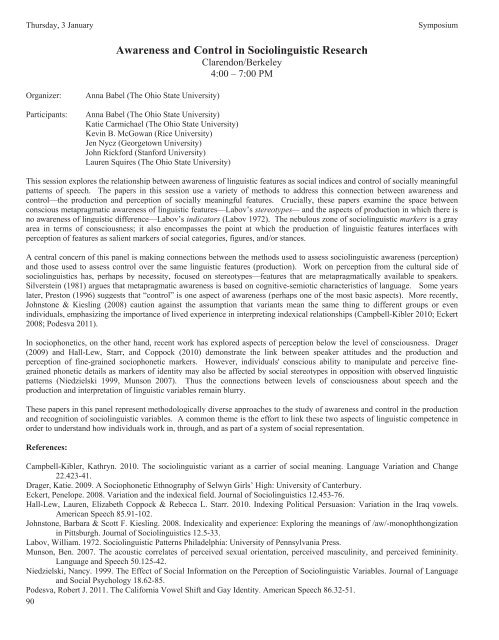here - Linguistic Society of America
here - Linguistic Society of America
here - Linguistic Society of America
You also want an ePaper? Increase the reach of your titles
YUMPU automatically turns print PDFs into web optimized ePapers that Google loves.
Thursday, 3 JanuarySymposiumAwareness and Control in Sociolinguistic ResearchClarendon/Berkeley4:00 – 7:00 PMOrganizer:Participants:Anna Babel (The Ohio State University)Anna Babel (The Ohio State University)Katie Carmichael (The Ohio State University)Kevin B. McGowan (Rice University)Jen Nycz (Georgetown University)John Rickford (Stanford University)Lauren Squires (The Ohio State University)This session explores the relationship between awareness <strong>of</strong> linguistic features as social indices and control <strong>of</strong> socially meaningfulpatterns <strong>of</strong> speech. The papers in this session use a variety <strong>of</strong> methods to address this connection between awareness andcontrol—the production and perception <strong>of</strong> socially meaningful features. Crucially, these papers examine the space betweenconscious metapragmatic awareness <strong>of</strong> linguistic features—Labov’s stereotypes— and the aspects <strong>of</strong> production in which t<strong>here</strong> isno awareness <strong>of</strong> linguistic difference—Labov’s indicators (Labov 1972). The nebulous zone <strong>of</strong> sociolinguistic markers is a grayarea in terms <strong>of</strong> consciousness; it also encompasses the point at which the production <strong>of</strong> linguistic features interfaces withperception <strong>of</strong> features as salient markers <strong>of</strong> social categories, figures, and/or stances.A central concern <strong>of</strong> this panel is making connections between the methods used to assess sociolinguistic awareness (perception)and those used to assess control over the same linguistic features (production). Work on perception from the cultural side <strong>of</strong>sociolinguistics has, perhaps by necessity, focused on stereotypes—features that are metapragmatically available to speakers.Silverstein (1981) argues that metapragmatic awareness is based on cognitive-semiotic characteristics <strong>of</strong> language. Some yearslater, Preston (1996) suggests that “control” is one aspect <strong>of</strong> awareness (perhaps one <strong>of</strong> the most basic aspects). More recently,Johnstone & Kiesling (2008) caution against the assumption that variants mean the same thing to different groups or evenindividuals, emphasizing the importance <strong>of</strong> lived experience in interpreting indexical relationships (Campbell-Kibler 2010; Eckert2008; Podesva 2011).In sociophonetics, on the other hand, recent work has explored aspects <strong>of</strong> perception below the level <strong>of</strong> consciousness. Drager(2009) and Hall-Lew, Starr, and Coppock (2010) demonstrate the link between speaker attitudes and the production andperception <strong>of</strong> fine-grained sociophonetic markers. However, individuals' conscious ability to manipulate and perceive finegrainedphonetic details as markers <strong>of</strong> identity may also be affected by social stereotypes in opposition with observed linguisticpatterns (Niedzielski 1999, Munson 2007). Thus the connections between levels <strong>of</strong> consciousness about speech and theproduction and interpretation <strong>of</strong> linguistic variables remain blurry.These papers in this panel represent methodologically diverse approaches to the study <strong>of</strong> awareness and control in the productionand recognition <strong>of</strong> sociolinguistic variables. A common theme is the effort to link these two aspects <strong>of</strong> linguistic competence inorder to understand how individuals work in, through, and as part <strong>of</strong> a system <strong>of</strong> social representation.References:Campbell-Kibler, Kathryn. 2010. The sociolinguistic variant as a carrier <strong>of</strong> social meaning. Language Variation and Change22.423-41.Drager, Katie. 2009. A Sociophonetic Ethnography <strong>of</strong> Selwyn Girls’ High: University <strong>of</strong> Canterbury.Eckert, Penelope. 2008. Variation and the indexical field. Journal <strong>of</strong> Sociolinguistics 12.453-76.Hall-Lew, Lauren, Elizabeth Coppock & Rebecca L. Starr. 2010. Indexing Political Persuasion: Variation in the Iraq vowels.<strong>America</strong>n Speech 85.91-102.Johnstone, Barbara & Scott F. Kiesling. 2008. Indexicality and experience: Exploring the meanings <strong>of</strong> /aw/-monophthongizationin Pittsburgh. Journal <strong>of</strong> Sociolinguistics 12.5-33.Labov, William. 1972. Sociolinguistic Patterns Philadelphia: University <strong>of</strong> Pennsylvania Press.Munson, Ben. 2007. The acoustic correlates <strong>of</strong> perceived sexual orientation, perceived masculinity, and perceived femininity.Language and Speech 50.125-42.Niedzielski, Nancy. 1999. The Effect <strong>of</strong> Social Information on the Perception <strong>of</strong> Sociolinguistic Variables. Journal <strong>of</strong> Languageand Social Psychology 18.62-85.Podesva, Robert J. 2011. The California Vowel Shift and Gay Identity. <strong>America</strong>n Speech 86.32-51.90
















